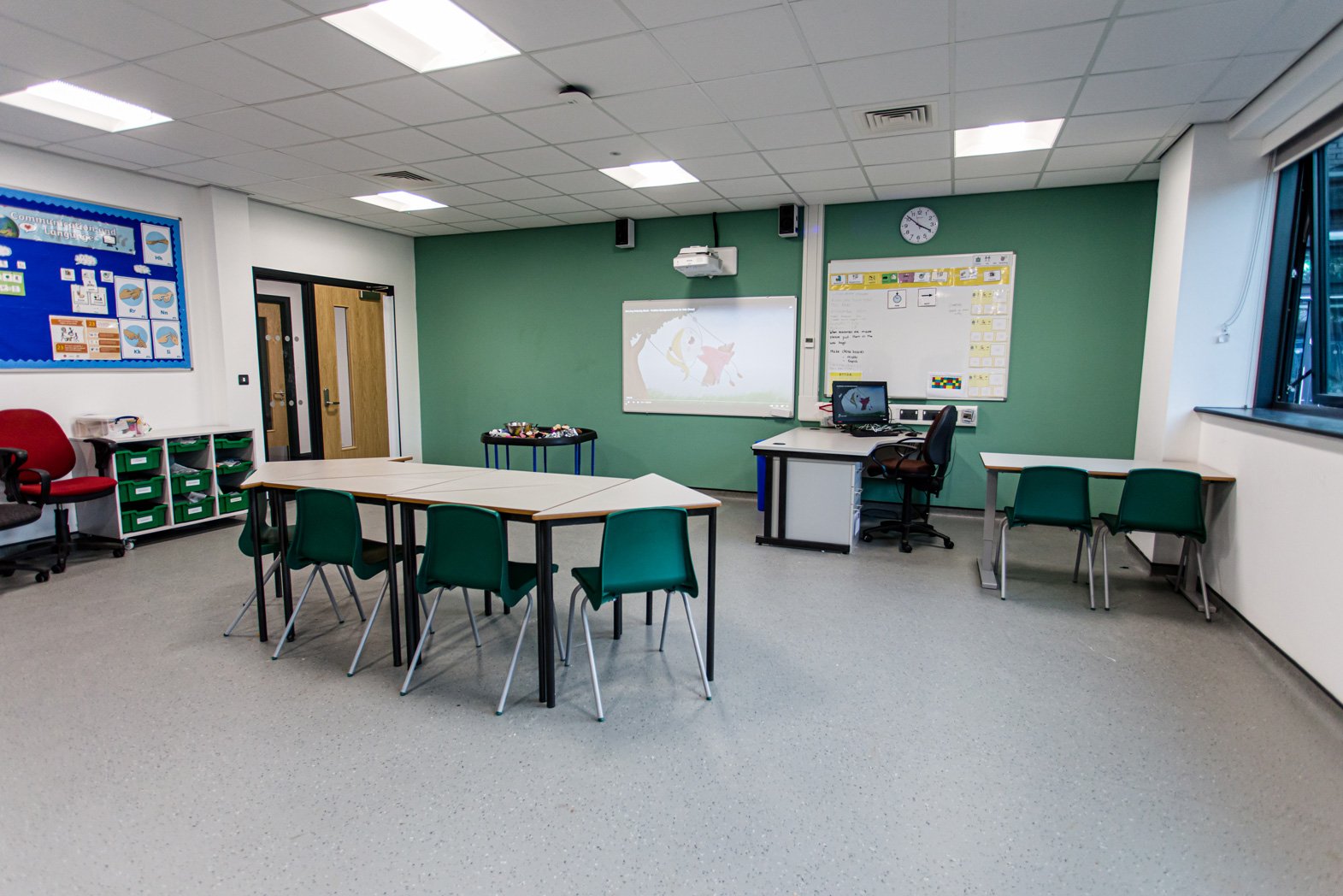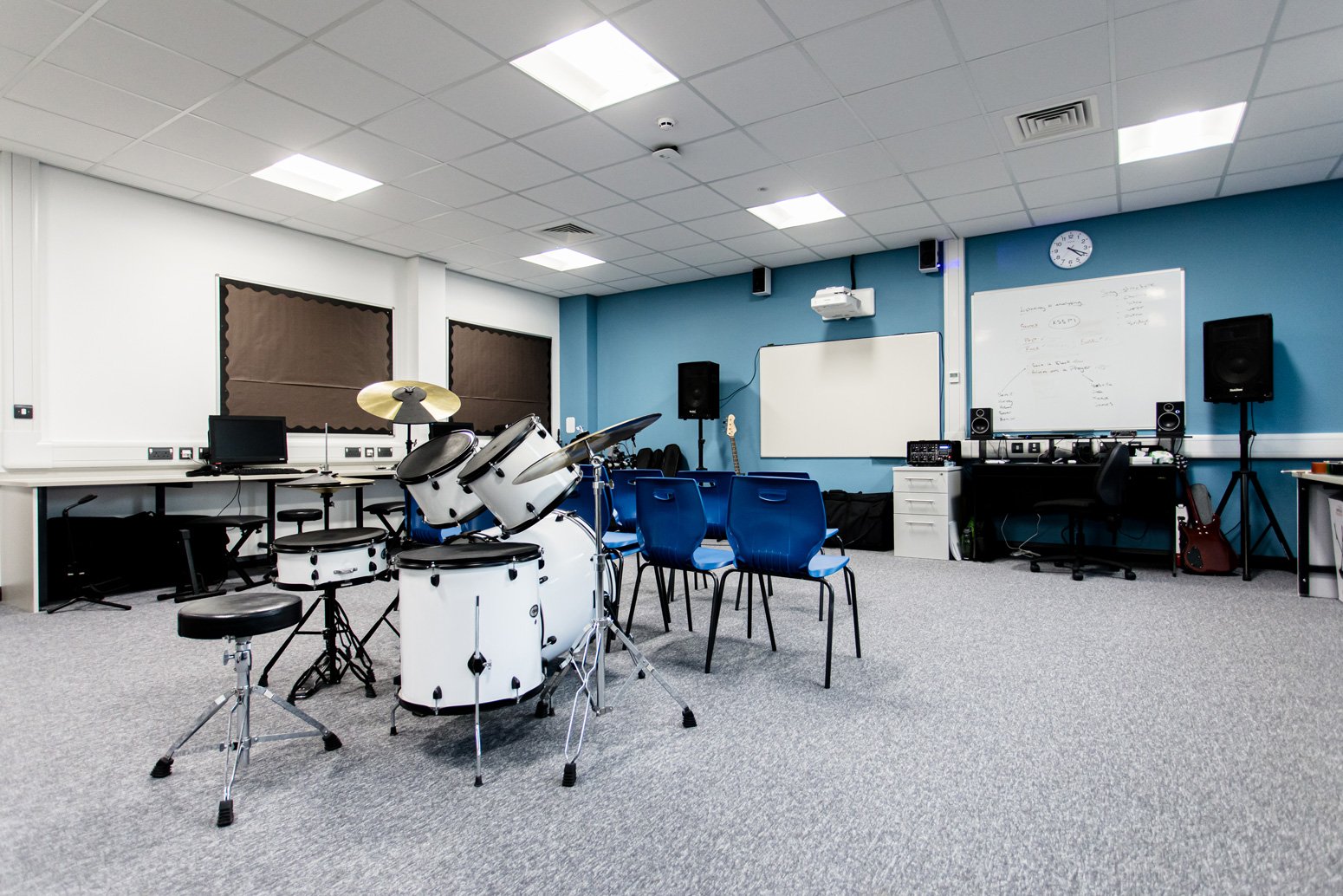Article 12: Every child has the right to have a say in all matters affecting them, and to have their views taken seriously.
Article 31: Leisure, play and culture - Every child has the right to relax, play and take part in a wide range of cultural and artistic activities.
We are a Unicef Rights Respecting School. The Rights Respecting School Award puts children's rights at the heart of schools in the UK.
We aim to be a safe and inspiring place to learn, where children are respected, their talents and nurtured and they are able to thrive.
The Rights Respecting Schools Award embeds these values in daily school life at Oscott Manor School and gives children the best chance to lead happy, healthy lives and to be responsible, active citizens.
Our curriculum intent at Oscott Manor
The curriculum at Oscott Manor is based on the National curriculum adapted to be responsive to the unique learning profiles of our pupils. We have three pathways of learning – Pioneers, Discoverers and Explorers.
These pathways are designed to be broad and balanced, ensuring that each pupil receives a comprehensive education that respects their individual rights and prepares them for adulthood. At Oscott Manor, we are dedicated to being a Rights-Respecting school, underpinning our curriculum with the principles of all stakeholders being Ready, Respectful and Safe.
By adapting the National Curriculum to fit the diverse learning profiles of our pupils, we ensure that our education provision is both inclusive and aspirational. Our goal is to equip each pupil with the knowledge, skills, and confidence they need to navigate adulthood successfully.
We have been working hard to improve the curriculum at Oscott. This curriculum will begin in September 2025.
Curriculum Aims:
Prepare pupils for life in modern Britain ensuring they are able to navigate life challenges as safely as possible.
Equip pupils with the life-skills, independence and social skills to be able to take care of themselves at school at home and in the wider community, within their capabilities.
Motivate and inspire our pupils towards a lifelong interest in learning and where appropriate, develop aspirations for voluntary or paid employment beyond school.
Ensure that our pupils are able to go forward beyond their school career and enjoy a productive and contented life as part of a community.
Our three pathways of learning
There are three pathways of learning within our curriculum. Individual needs and assessment outcomes are used to determine the curriculum pathway which a pupil will follow. The Pioneers and Discoverers pathways are considered subject-specific learning, and the Explorer pathway is developed within the framework of the Engagement model. Where a pupil changes in their development and progress, they are able to move between the pathways. An overlap in the pathways allow for these transitions to occur.
Explorer Pathway
A pupil on the Explore pathway at Oscott Manor will have autism alongside additional complex needs.
An 'explorer’ will typically present with significant communication delay and use a communication aid such as ALD board, Picture Exchange Communication Systems (PECS) and assistive technology devices at all times.
-
These pupils will have limited or no verbal communication and will be prompted and supported by staff to use different strategies to communicate with the aim that they are able to communicate independently over time. A pupil on the Explore pathway will typically work within the range of early childhood development to Key stage 1 expectations. They may receive accreditations in the range of Pre-Entry to Entry Level 2.
A pupil on the Explore pathway typically presents with sensory sensitivities and may have significant behaviours that challenge. A tailored sensory diet and environment with high staff to pupil ratio allows students to access regular periods of regulation supported with input from Occupational Therapists, Speech and Language Therapists, Education Psychologists and our own Pastoral Team.
The education provision for these pupils has a strong emphasis on creating a structured and predictable learning environment, with adaptations made to support individuals where required. The classroom environment is rich with communication opportunities with visual timetables and prompts on display. Pupils are given opportunities to communicate using a range of different communication aids. A low arousal approach may be used where appropriate for pupils. Classrooms are set up with defined learning areas in addition to sensory integration areas and quiet areas. Pupils have regular access to outdoor spaces.
Discoverers Pathway
A Discoverers pupil with autism at Oscott Manor School typically presents with moderate communication and social development difficulties and may present with behavioural challenges.
These pupils may have basic verbal communication skills with some relying on visual aids and alternative methods to ensure effective communication.
-
The learning environment for these pupils is structured using visual timetables and predictable routines and now and next boards to minimise anxiety and support learning. Group activities are incorporated to foster social interaction and cooperative learning, giving pupils opportunities to work alongside peers and create a positive environment within acceptable social norms. The focus is on developing emotional intelligence, resilience, and social skills.
The Discoverers curriculum is based on the National Curriculum, with subject specific learning. Pupils on this pathway work within the range of Key Stage 1 to Key Stage 2 expectations. They may receive accreditation or acknowledgement of learning in a range from Entry 1 to Entry 3. At Key Stage 4 and Key Stage 5 pupils have the opportunity to choose “options” to study a range accreditations or recognition of learning.
The semi-formal curriculum at Oscott Manor emphasises academic achievement alongside life skills and social development. Pupils engage in learning experiences that are practical and meaningful, with all subjects having real-life applications emphasised. Multi-disciplinary teams, including Speech and Language Therapists, Occupational Therapists, Educational Psychologists and the school Pastoral Team contribute to the tailored support each pupil receives.
Pioneers Pathway
A Pioneers pupil with autism on the Pioneers pathway at Oscott Manor School may typically present with some communication, social and behavioural challenges.
Most pupils will be able to communicate verbally, though may have difficulty expressing feelings and emotions which can lead to periods of dysregulation.
-
The learning environment for these pupils is structured using visual timetables and predictable routines and now and next boards to minimise anxiety and support learning. Group activities are incorporated to foster social interaction and cooperative learning, giving pupils opportunities to work alongside peers and create a positive environment within acceptable social norms. The focus is on developing emotional intelligence, resilience, and social skills.
The Pioneers curriculum is based on the National Curriculum, with subject specific learning. Pupils on this pathway work within the range of Key Stage 2 to age related expectations. They may receive accreditation from Entry 3 to Level 1 to Level 2. Pupils on this pathway generally access core and specialist lessons with subject specific staff.
At Key Stage 4 and Key Stage 5 pupils have the opportunity to choose “options” to study a range of BTEC, GCSE courses or equivalent accreditations.
The Pioneers curriculum emphasises academic progress alongside personal and social development, with preparation for adulthood embedded throughout all subjects. This is to give pupils the skills that they need to transition to further education and adult life.
How so we decide on Pathways?
When a pupil initially joins the school, we use a range of information to place each pupil on a given pathway. Depending on progress and development a pupil may change pathway throughout their school career. Information is taken from the EHCP, home visits and information given from the previous setting alongside information and observations gained through the transition process. We ensure we visit the previous setting and the family home to observe each pupil that joins Oscott Manor where appropriate to do so. Within the first term with us the class teachers will form an initial baseline assessment using our Bsquared frameworks and reading assessments, which will also support pathway selection.
|
Pathway |
Characteristic of pupil |
Communication |
Provision and Engagement |
Curriculum |
Focus |
Developmental levels |
|
Explorers |
SLD Complex attention and interaction need. Inability to tolerate uncertainty. Unable to tolerate others or demand, highly self-directed. May tolerate low level demand. Some early subject specific learning |
Pre-Intentional Communication to Intentional: Pupils begin to use specific behaviours intentionally to communicate. They may use gestures, vocalizations, or simple signs to convey messages. Pointing to an object they want, using a specific sound to get attention, or signing "more" during an activity. Encouraging the use of gestures and signs, modelling communication behaviours, and using visual aids to support understanding. Focus on developing social communication partners |
Areas of Engagement: Persistence, Anticipation, Initiation, Exploration, Realisation. Low demand Play based approach Facilitated by motivating environment. Adult initiated to fleeting engagement Pupils at this level show initial signs of awareness and interaction with their environment. They may respond to stimuli such as sounds, lights, or touch. Turning towards a sound, showing interest in a new object, or making eye contact with a teacher. Use of sensory activities, consistent routines, and one-on-one interactions to build familiarity and comfort. |
English x5 Maths x5 Art and Design x2 Community Inclusion x2 Forest School x2 Music x1 Physical Education x2 Preparing For Adulthood x2 PSHE x2 Wider World x2 |
Independence Early development skills Communication and independence |
Early childhood development to 5 years Reception Engagement Steps ES4-ES6 / Progression Steps 1-2 |
|
Discoverers |
SLD Independently initiates meaningful engagement across a range of contexts and environments |
Pupils use symbols, words, or sentences to communicate more complex ideas. They can engage in back-and-forth interactions and understand the use of language for different purposes. Examples: Using picture cards to make choices, forming simple sentences to express needs, or participating in conversations. Providing access to communication devices or picture exchange systems, encouraging verbal communication, and offering opportunities for social interaction. Focus on developing language communication partners |
Subject Specific learning Pupils actively participate in activities and show a clear understanding of cause and effect. They may initiate interactions and demonstrate preferences. Choosing a preferred activity, following simple instructions, or engaging in turn-taking games. Providing choices, encouraging communication through various means (verbal, sign, or AAC devices), and using positive reinforcement. |
English x5 Maths x4 Science x2 Art and Design x1 Computing x1 Design Technology/Food x2 Drama x1 Forest School x1 Geography x1 History x1 Music x2 Phonics and Reading Daily Physical Education x2 PSHE x1 Religious Education x1 |
Communication and independence and social interactions Thinking and Problem solving |
5 to 7 years NC Yr1 to Yr3 Progression Steps 4-7 PKS4-PKS6 |
|
Pioneers |
SLD/MLD Accesses subject specific learning in most areas. |
Focus on Conversation communication partners |
Consistent persistence at learning. Pupils maintain focus and interest in activities over extended periods. They can work towards goals and show problem-solving skills. Completing a task independently, participating in group activities, or using learned skills in new situations. Setting achievable goals, offering challenges to extend learning, and promoting independence through structured activities. |
English x5 Maths x4 Science x2 Art and Design x1 Computing x1 Design Technology/Food x2 Drama x1 Enrichment x1 Geography x1 History x1 Music x2 Phonics and Reading Daily Physical Education x2 PSHE x1 Religious Education x1 |
Application of knowledge and skills to a wider range on contexts |
8 to 11 years NC Yr3-Yr6 |
Rights Respecting School
At Oscott Manor, the principles of Rights Respecting Schools are woven into the fabric of everyday life and the curriculum. This approach ensures that every pupil, regardless of their abilities, feels valued and respected. In the classroom, lessons are designed to highlight the importance of respect, equality, and dignity. For example, in literacy, pupils might read stories that emphasise these themes, while in PSHE, they engage in activities that teach them about their rights and how to advocate for themselves and others.
Throughout the school day, staff model respectful behaviour and create an inclusive environment where every pupil's voice is heard. Collaborative projects in subjects like art and science encourage teamwork and mutual respect. In physical education, activities are adapted to ensure all pupils can participate fully, promoting a sense of belonging and inclusion.
By embedding these principles into every aspect of school life, we create a supportive and empowering environment that helps pupils thrive academically, socially, and emotionally. This holistic approach not only enhances learning but also fosters a community where every pupil feels respected and valued.
Zones of Regulation
The Zones of Regulation framework is integrated into daily life and the curriculum to support pupils' emotional and sensory regulation. This approach helps pupils recognise and manage their emotions, leading to better self-control and social interactions. Each day begins with a check-in where pupils identify their current "zone" (Blue, Green, Yellow, or Red) and discuss strategies to move towards the optimal Green Zone for learning.
Teachers incorporate Zones of Regulation into various subjects. For instance, in literacy, pupils might read stories that explore characters' emotions and discuss how they could use regulation strategies. In art, pupils create visual representations of different zones and their associated feelings. During physical education, activities are designed to help pupils recognise how physical activity can influence their emotional state.
Throughout the school, visual aids and sensory tools are readily available to help pupils self-regulate. Staff consistently model and reinforce the use of regulation strategies, creating a supportive environment where pupils feel understood and empowered to manage their emotions. This holistic integration of the Zones of Regulation fosters a positive and inclusive school culture, enhancing both academic and social-emotional development.
The different Key Stages at Oscott Manor School
Key Stage 3
Key Stage 4
Sixth Form
Reading
We provide daily instruction in phonics and reading, utilising the "Little Wandle" phonics scheme. For students who find this approach challenging, we also offer a sight-reading program called "All by Myself." At our school, we prioritise phonics and reading instruction on a daily basis. We utilise the “Little Wandle” phonics scheme, which is designed to systematically teach pupils the relationship between letters and sounds, helping them to decode words effectively.
Alternative Reading Programmes
The “All by Myself” programme focuses on helping pupils recognise whole words by sight, which can be particularly beneficial for those who struggle with phonics-based approaches.
Assessment of Reading Progress
To ensure that each pupil is progressing in their reading skills, we conduct assessments every term. We use the Salford reading test and the Little Wandle assessment system to evaluate their reading abilities. These assessments help us identify areas where pupils may need additional support and track their progress over time.
Progression Through Reading Stages
Once pupils have successfully completed the phonics stages of reading, they transition to colour banded books. These books are categorised by levels, allowing pupils to gradually build their reading skills and confidence.
After mastering the colour banded books, pupils become free readers. At this stage, they are exposed to a wider range of higher-level reading materials, encouraging them to explore different genres and develop a deeper love for reading.
Enrichment
Enrichment is a dedicated slot in the timetable where pupils can choose from a variety of activities beyond the standard curriculum. These activities include crafts, board games, gardening, and boxercise, among many others. These activities are a supplement to the curriculum and a clear emphasis is placed on the development of communication for pupils– understanding themselves and developing new interests and skills to bolster self-worth; collaborating and promoting work with peers and helping to develop skills to communicate needs and ideas with staff, parents and family members and ultimately wider society and the communities in which they live.










